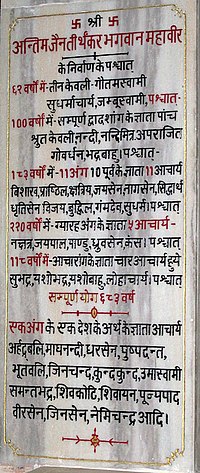Kundakunda
This article needs additional citations for verification. (September 2015) |
Kundakunda | |
|---|---|
 Idol of KundaKunda, Karnataka | |
| Personal | |
| Born | 2nd century CE[1] |
| Religion | Jainism |
| Sect | Digambara |
| Part of a series on |
| Jainism |
|---|
 |
Kunda kunda was a Digambara Jain monk and philosopher, who likely lived in the second century CE or later.[2][3][4]
His date of birth is māgha māsa, śukla pakṣa, pañcamī tithi, on the day of Vasant Panchami. He authored many
Names
His proper name was Padmanandin,
Biography

Kundakunda belonged to the Digambara sect. Natubhai Shah places him in the second-century CE.[3] Jayandra Soni places him in either the 2nd– or 3rd–century CE.[2] Western scholars, however, place him much later primarily because of ideas he refers to and because his hagiography and quotations from his influential and important work begin to appear around 8th-century CE. For example, Paul Dundas dates him to about mid-8th-century.[7][8]
In the Digambara tradition, Kundakunda's texts are among the most important and treasured. The reverence for his scholarship is such that some later texts such as Pravachanasara list him third in importance, right after Mahavira and Mahavira's disciple Indrabhuti Gautama.
Thought
In texts such as Pravacanasāra (‘The Essence of the Doctrine’) and Samayasāra (‘The Essence of the Soul’), Kundakunda distinguishes between two perspectives of truth:
- vyavahāranaya or ‘mundane perspective’, also delusion (moha)
- niścayanaya or ‘ultimate perspective’, also called “supreme” (paramārtha) and “pure” (śuddha)[11]
For Kundakunda, the mundane realm of truth is also the relative perspective of normal folk, where the workings of
Works


The works attributed to Kundakunda, all of them in Prakrit,[6] can be divided in three groups.
The first group comprises four original works described as "
The second group is a collection of ten bhaktis (devotional prayers), short compositions in praise of the
The last group consists of eight short texts called Prabhrta (Pkt. pahuda, i.e., a gift or a treatise), probably compilations from some older sources, on such topics as the right view (Darsanaprabhrta, in 36 verses), right conduct (Charitraprabhrta, in 44 verses), the scripture (Sutraprabhrta, in 27 verses), and so forth.
See also
- Simandhar Swami
- Kundadri
- Taran Svami
Notes
- ^ Natubhai Shah 2004, pp. 28.
- ^ a b Jayandra Soni 2003, pp. 25–26.
- ^ a b c d Natubhai Shah 2004, p. 48.
- ^ a b "Shri Kundkundacharya". Shrimad Rajchandra Adyatmik Sadhana Kendra, Koba. Archived from the original on 24 March 2022. Retrieved 28 June 2020.
- ^ a b Jayandra Soni 2003, p. 26.
- ^ a b Upinder Singh 2008, p. 524.
- ^ Dundas 2002, pp. 107–108.
- ^ Long 2013, pp. 65–66.
- ^ Jaini 1991, p. 32.
- ^ Jaini 1991, p. 32–33.
- ^ a b Long 2013, p. 126.
- ^ Long 2013, p. 128.
References
- ISBN 0-7914-3785-X
- Dundas, Paul (2002). The Jains. Routledge. ISBN 978-0-415-26606-2.
- Jain, Vijay K. (2012), Acharya Kundkund's Samayasara, Vikalp Printers, ISBN 978-81-903639-3-8
- Jayandra Soni (2003) [2002], ISBN 81-208-1977-2
- Jaini, Padmanabh (1991), Gender and Salvation: Jaina Debates on the Spiritual Liberation of Women, Berkeley: University of California Press
- Long, Jeffery D. (2013). Jainism: An Introduction. I.B.Tauris. ISBN 978-0-85771-392-6.
- ISBN 81-208-1938-1
- ISBN 978-81-317-1120-0
- Dhaky, M.A.; Jain, Sagarmal, eds. (1991), The Date of Kundakundācārya, Aspects of Jainology Vol. III: Pt. Dalsukh Bhai Malvania Felicitation Volume I. Varanasi, vol. I, pp. 187–206
